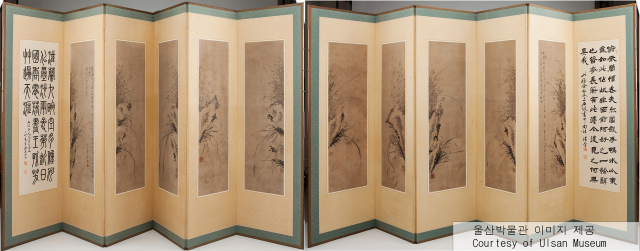
Seokran-do Folding Screen
Seokpa Yi Ha-eung
These elegant orchid paintings were created by someone you might not expect—Lee Ha-eung, better known as Heungseon Daewongun, the powerful regent who ruled Korea in the 19th century.
Strange, isn't it? Why would someone at the peak of political power paint such humble orchids?
Look at this folding screen with eight panels. Each shows orchids and rocks, but they're not identical. Like moments in a life, each panel tells a different story while connecting to the whole.
The orchid was special in Korean culture—it represented integrity and noble character. For Lee Ha-eung, these flowers were like a mirror of how he saw himself. No matter how strong the political winds, he would bend but not break.
Notice his brushwork. It's completely different from his political speeches. No exaggeration, no showiness, just quiet honesty. Using only black ink and varying tones, he created such vivid life. This is the power of traditional ink painting.
Look at this magnolia painting too. Without bright colors, he captured such graceful flowers. The soft petals contrast with the strong branches—gentle power, you might say.
His calligraphy shows the same qualities. The writing is both bold and flowing, strong yet flexible. The rhythm of his brushstrokes creates a kind of visual music.
For Lee Ha-eung, painting and writing were probably his only escape from power struggles. Here he could face his true feelings instead of political calculations.
See how he uses empty space? In Asian art, emptiness isn't just background—it's full of meaning. In Lee Ha-eung's paintings, this silence might hold the loneliness and reflection that a powerful man couldn't express publicly.
Power fades, but art remains. These quiet paintings still move us today, showing us the human heart behind the historical figure.
Strange, isn't it? Why would someone at the peak of political power paint such humble orchids?
Look at this folding screen with eight panels. Each shows orchids and rocks, but they're not identical. Like moments in a life, each panel tells a different story while connecting to the whole.
The orchid was special in Korean culture—it represented integrity and noble character. For Lee Ha-eung, these flowers were like a mirror of how he saw himself. No matter how strong the political winds, he would bend but not break.
Notice his brushwork. It's completely different from his political speeches. No exaggeration, no showiness, just quiet honesty. Using only black ink and varying tones, he created such vivid life. This is the power of traditional ink painting.
Look at this magnolia painting too. Without bright colors, he captured such graceful flowers. The soft petals contrast with the strong branches—gentle power, you might say.
His calligraphy shows the same qualities. The writing is both bold and flowing, strong yet flexible. The rhythm of his brushstrokes creates a kind of visual music.
For Lee Ha-eung, painting and writing were probably his only escape from power struggles. Here he could face his true feelings instead of political calculations.
See how he uses empty space? In Asian art, emptiness isn't just background—it's full of meaning. In Lee Ha-eung's paintings, this silence might hold the loneliness and reflection that a powerful man couldn't express publicly.
Power fades, but art remains. These quiet paintings still move us today, showing us the human heart behind the historical figure.
